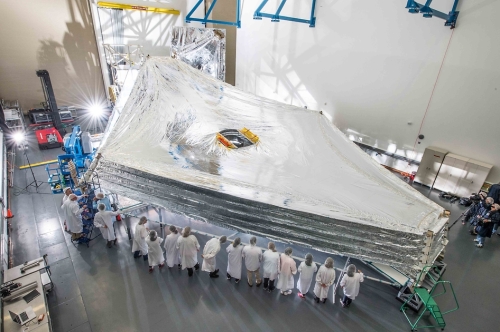
(Photo Credit: NASA/Chris Gunn)
This is the massive sunshield that will protect NASA’s upcoming James Webb Space Telescope when in orbit, and it has just passed its first major test.
The sunshield on the telescope is the largest part of the space observatory. Five layers of thin membrane have to unfurl reliably and precisely once the craft has been deployed into orbit in order for the telescope to perform. Now, for the first time, engineers have stacked and unfurled a full-sized test unit of the sunshield, and it worked perfectly.
The shield is massive, as demonstrated by this picture. It measures about the length of a tennis court, therefore it will be folded up like an umbrella around the Webb telescope’s mirrors and instruments during launch. Once it reaches its orbit, the Webb telescope will be commanded to unfold, and separate the sunshield’s five layers into their precisely stacked arrangement with its kite-like shape.
The protective material will separate the observatory into a warm sun-facing side and a cold side where the sunshine is blocked from interfering with the sensitive infrared instruments.
The infrared instruments have to be kept very cold (under -370 degrees F) to operate, so the sunshield must protect these sensitive instruments with an effective sun protection factor (or SPF) of 1,000,000. By comparison, suntan lotion generally has an SPF between 8-50.
In addition to ensuring that certain instruments are maintained in a cold environment, the shield also provides a thermally stable environment. The stability is essential to maintaining proper alignment of the primary mirror segments as the telescope changes its orientation to the sun.
The James Webb Space Telescope is an incredibly complex and advanced piece of technology, which is why it is the successor to NASA’s Hubble Space Telescope. Webb will become the most powerful space telescope ever built, thanks to an international project led by NASA, the European Space Agency and the Canadian Space Agency.
Webb is optimized to observe longer wavelengths of light than the Hubble Space Telescope which will enable it to look further back in time to see the first galaxies that formed in the early universe. It will also peer inside dust clouds where stars and planetary systems are forming today.
It is scheduled to launch in 2018.
Click here for more information about the James Webb Space Telescope.